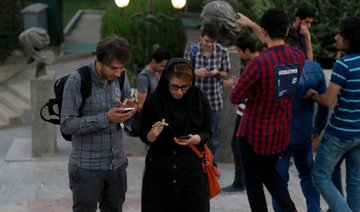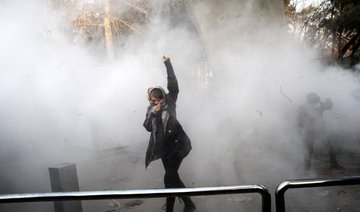TEHRAN: Some 200 protesters marched through central Tehran Sunday as authorities braced for a possible fourth night of unrest and cut access to social media after days of unrest that saw two people killed.
A security deputy for Tehran’s governor told the ILNA news agency that 200 people had been arrested after protests on Saturday night — including 40 “leaders.”
The interior minister warned that protesters will “pay the price” as footage on social media showed thousands marching across the country overnight in the biggest test for the Islamic republic since mass demonstrations in 2009.
The demonstrations began in second city Mashhad on Thursday over high living costs, but quickly spread and turned against the system as a whole, with slogans such as “Death to the dictator.”
Lorestan province deputy governor Habibollah Khojastehpour told state television that two people were killed in clashes in the small western town of Dorud late Saturday, but denied security forces were responsible.
In an apparent attempt to stave off more unrest, the authorities began blocking access to photo sharing and online messaging services on mobile phones, including Telegram, which the government accused of being used to foment violence, local media and Telegram’s CEO said.
The conservative-linked Fars news agency said around 200 people were taking part in the latest protest in Tehran.
“Contrary to rumors from hostile media, most parts of Tehran are calm. Around 200 people are occasionally chanting here and there,” it said.
Fars said shops closed early Sunday “for fear of damage to their shops by rioters.”
After initial silence, state media has shown footage of unrest, focusing on young men violently targeting banks and vehicles, an attack on a town hall in Tehran, and images of a man burning the Iranian flag.
“Those who damage public property, disrupt order and break the law must be responsible for their behavior and pay the price,” Interior Minister Abdolrahman Rahmani Fazli said on state television.
“The spreading of violence, fear and terror will definitely be confronted,” he added.
US President Donald Trump said the “big protests” showed people “were getting wise as to how their money and wealth is being stolen and squandered on terrorism.”
“Looks like they will not take it any longer,” he wrote on Twitter, warning that Washington is “watching very closely for human rights violations!“
Trump’s ambassador to the UN, Nikki Haley, said Iran’s government was “being tested by its own citizens.”
Iranian authorities have sought to distinguish anti-regime protesters from what they see as legitimate economic grievances.
“Do not get excited,” parliament director for international affairs Hossein Amir-Abdollahian wrote in a tweet directed at Trump.
“Sedition, unrest and chaos are different from gatherings and peaceful protests to pursue people’s livelihoods,” he said.
But there have been reminders of the continued support for the regime among conservative sections of society, with pro-regime students holding another day of demonstrations at the University of Tehran.
They had outnumbered protesters at the university on Saturday.
The total number of arrests from the protests around the country remained unclear.
Several hundred people were shown gathering in the western city of Kermanshah Sunday, according to footage shared online by a group linked to the powerful Revolutionary Guards.
An official in Arak, around 300 kilometers (190 miles) southwest of Tehran, said 80 people had been detained there overnight.
Police have so far taken a relatively soft approach to the unrest.
President Hassan Rouhani has not yet made any statement since the protests started.
He came to power in 2013 promising to mend the economy and ease social tensions, but anger over high living costs and a 12-percent unemployment rate have left many feeling that progress is too slow.
Unemployment is particularly high among young people, who have grown up in a less restrictive environment and are generally considered less deferential to authority.
“Rouhani has run an austerity budget since 2013 with the idea that it’s a tough but necessary pill to swallow to manage inflation and currency problems and try to improve Iran’s attractiveness for investment,” said Esfandyar Batmanghelidj, founder of the Europe-Iran Forum.
“But choosing years of austerity immediately after a very tough period of sanctions is bound to test people’s patience,” he told AFP.
Since the ruthless repression of the 2009 protests against a disputed presidential election that gave hard-liner Mahmoud Ahmadinejad a second term, many middle-class Iranians have abandoned hope of securing change from the streets.
But low-level strikes and demonstrations have continued, with bus drivers, teachers and factory workers protesting against unpaid wages and poor conditions.
Protesters march again in Tehran as 200 arrested, 2 killed
Protesters march again in Tehran as 200 arrested, 2 killed

Beirut airport busy with Eid visitors despite tense security situation

- Motorcyclist killed in Israeli drone strike as Hezbollah keeps up retaliatory attacks
- Festival brings challenges for Lebanese forced to flee their homes
BEIRUT: Beirut’s Rafic Hariri International Airport witnessed an influx of arrivals on Saturday as Lebanese expatriates and tourists ignored the hostilities in the south and traveled to celebrate the Eid Al-Adha holiday.
European embassies had earlier issued warnings against visiting Lebanon because of the tense security situation, but these failed to deter expatriates and visitors, mainly from Iraq and Egypt, arriving for Eid.
On the eve of the holiday, there was a noticeable discrepancy in the prices of sacrificial animals in the Lebanese market, along with an unjustified increase in meat prices.
Majed Eid, secretary of the Syndicate of Butchers, Importers, and Traders of Live Livestock, said that imports of sacrificial animals from abroad had fallen this year compared with previous years.
The security situation in the Tyre area has led to reduced shopping activities as Eid approaches, despite the substantial influx of expatriates who typically boost commercial and economic activity there.
Tyre Traders Association Secretary Ghazwan Halawani said that the preparations for Eid seemed ordinary, with no noticeable improvement in commercial activity, sales, or market visitors.
He attributed the decline to anxiety over military operations on the border and Israeli attacks on civilians.
On the eve of Eid Al-Adha, thousands of families from the southern region headed to their villages near the border despite the hostilities.
Issa, a butcher, planned to spend the holiday with his family, even though his area had been sporadically shelled in the past few months.
“Nothing will happen to us except what God has destined for us,” he said.
The Eid holiday will be challenging for the people of the south, especially those who fled their villages eight months ago.
Eid Al-Adha presents significant challenges for the displaced southerners, with almost 100,000 people forced to leave their villages.
Nabatieh Gov. Hwaida Turk told Arab News that 65 towns in Nabatieh Governorate had been subjected to “systematic shelling and fires due to Israeli attacks.”
Some towns were almost destroyed, she said.
Turk said that residents of the front-line towns, especially in the Marjayoun and Hasbaya areas, did not return for Eid.
However, villages and towns to the rear are crowded with displaced people alongside their original inhabitants.
She said the people in the southern region tried to celebrate Eid with hope despite the difficult economic conditions.
Hezbollah kept up retaliatory attacks on Israel on Saturday, days after an airstrike killed one of its commanders.
Aerial attacks on both sides escalated, with Hezbollah saying that it carried out an attack “with a fleet of suicide drones on the Khirbet Maer base, destroying part of it.”
The attack was in response to the killing of a senior Hezbollah commander, Sami Hassan Taleb, nicknamed Abu Taleb, along with three others, in an Israeli attack on their location in Jouaiyya several days ago.
Israeli Army Radio reported that a fire erupted in the Goren settlement in western Galilee after several Hezbollah drones struck the area.
As part of the escalation, Hezbollah targeted the headquarters of the air surveillance and operations management unit at the Meron base.
Israeli media outlets said that “two anti-armor missiles launched from the Meron base were targeted.”
Hezbollah said that it struck a group of Israeli soldiers at the Hadab Yaron site with a missile, killing or injuring several.
An Israeli military drone strike early on Saturday killed a motorcyclist at the Bint Jbeil–Maroun Ras intersection. Another person was injured in the resulting fire.
The outskirts of Deir Mimas and the Aaziyyeh Hill were subject to phosphorus shelling, causing fires to erupt in forests.
Israeli army spokesperson Avichay Adraee claimed that “an air force plane targeted a Hezbollah vandal in Aitaroun,” adding that “the Israeli army shelled the area with artillery.”
Palestinian teenager killed in West Bank raid

- Israel has killed at least 37,296 Palestinians in Gaza, mostly civilians, according to the territory’s health ministry
RAMALLAH: The Palestinian Health Ministry said Israeli troops shot dead a Palestinian teenager in the occupied West Bank on Saturday, as an army official confirmed troops opened fire during a raid.
Sultan Abdul Rahman Khatatbeh, 16, was killed by Israeli fire in the northern West Bank town of Beit Furik, the ministry said in a statement published on Facebook.
Palestinian news agency Wafa reported that two others were injured when Israeli forces stormed the town east of Nablus, “firing live bullets at local residents.”
HIGHLIGHTS
• Sultan Abdul Rahman Khatatbeh, 16, was killed by Israeli fire in the northern West Bank town of Beit Furik.
• Two others were injured when Israeli forces stormed the town east of Nablus, ‘firing live bullets at local residents.’
An Israeli military official said that troops were operating in the Nablus area when “dozens of suspects hurled rocks at Israeli security forces, who responded with riot dispersal means and live fire.”
“Hits were identified,” the official said.
The West Bank, which Israel has occupied since 1967, has seen a surge in violence for more than a year, particularly since the Israel-Hamas war in Gaza erupted on Oct. 7.
At least 546 Palestinians have been killed in the territory by Israeli troops or settlers since the Gaza war broke out, according to Palestinian officials.
At least 37,296 Palestinians have been killed in Israel’s military campaign, according to the Gaza Health Ministry.
Also on Saturday, the armed wing of Palestinian Islamic Jihad said the only way to return Israeli hostages is through Israel’s withdrawal from Gaza, ending its offensive and reaching a deal for exchanging Israeli hostages for Palestinian prisoners.
The spokesman of Al-Quds Brigades, the armed wing of the Palestinian group, made the remarks in a video posted on Telegram.
‘Miscalculation’ could lead to wider Hezbollah-Israel conflict, say UN officials

- “The danger of miscalculation leading to a sudden and wider conflict is very real,” the two officials said
- The United States and France are working on a negotiated settlement to the hostilities along Lebanon’s southern border
BEIRUT: There is a “very real” risk that a miscalculation along Lebanon’s southern border could trigger a wider conflict between Hezbollah and the Israeli military, two UN officials in Lebanon warned on Saturday.
The United Nations special coordinator for Lebanon, Jeanine Hennis-Plasschaert, and the head of UN peacekeeping forces in Lebanon, Aroldo Lazaro, said they were “deeply concerned” about the recent escalation along Lebanon’s border.
Iran-backed Hezbollah last week launched the largest volleys of rockets and drones yet in the eight months it has been exchanging fire with the Israeli military, in parallel with the Gaza war.
“The danger of miscalculation leading to a sudden and wider conflict is very real,” the two officials said in a written statement on Saturday.
The United States and France are working on a negotiated settlement to the hostilities along Lebanon’s southern border. Hezbollah says it will not halt fire unless Israel’s military offensive on Gaza stops.
Egyptian president tours Prophet’s biography museum

- El-Sisi explored the various creative pavilions that illustrate aspects of the Prophet Muhammad’s life
RIYADH: Egyptian President Abdel Fattah El-Sisi visited the International Fair and Museum of the Prophet’s Biography and Islamic Civilization in Madinah, Saudi Press Agency reported on Saturday.
During his tour on Friday, El-Sisi explored the various creative pavilions that illustrate aspects of the Prophet Muhammad’s life.
He viewed the panorama of the prophet’s chamber, which showcases authentic details of its construction and development through to the modern era.
El-Sisi was also introduced to a simulation of the Prophet’s pulpit, displayed through models and smart interactive screens. The exhibition highlighted the Kingdom’s efforts in serving the Qur’an and the Two Holy Mosques.
Expressing his admiration for the exhibition and museum project, El-Sisi extended his gratitude to King Salman and Crown Prince Mohammed bin Salman for their efforts and hospitality.
8 Israeli soldiers killed in southern Gaza

- The deaths will likely fuel calls for a ceasefire and heighten Israeli public anger over ultra-Orthodox exemptions from the military
- In January, 21 Israeli troops were killed in a single attack by Palestinian militants in Gaza
JERUSALEM: Israel’s military said Saturday that eight soldiers were killed in southern Gaza in the deadliest attack on Israeli forces in months.
The troops were killed in an explosion, the army said, without elaborating. The deaths will likely fuel calls for a ceasefire and heighten Israeli public anger over ultra-Orthodox exemptions from the military.
In January, 21 Israeli troops were killed in a single attack by Palestinian militants in Gaza.
Last month, Israel’s Supreme Court ordered an end to government subsidies for many ultra-Orthodox men who don’t serve in the army. A new draft law hasn’t been passed, but the coalition of Prime Minister Benjamin Netanyahu this week voted in favor of extending exemptions for religious men. Although the vote was only procedural, it caused an uproar by being approved during a war in which hundreds of soldiers have died and many others remain inside Gaza or on the front lines against Hezbollah militants in Lebanon.
Yoav Gallant, Israel’s Defense Minister and member of the country’s War Cabinet, has insisted that all sectors of Israeli society should contribute equally during its war against Hamas militants in the Gaza Strip.
Israel’s coalition government contains a powerful bloc of ultra-Orthodox parties that have been longtime partners of Netanyahu. If these parties leave the government, the country would be forced into new elections, with Netanyahu trailing significantly in the polls amid the war.
In Tel Aviv, anti-government protests have been ongoing for months, with many demonstrators calling for the immediate return of the hostages, along with Netanyahu’s resignation.
Israel’s bombardment and ground offensives in Gaza have killed more than 37,000 Palestinians, according to Palestinian health officials, who don’t give the breakdown of civilians and fighters. The war has also driven about 80 percent of the population of 2.3 million from their homes, and Israeli restrictions and ongoing fighting have hindered efforts to bring in humanitarian aid, fueling widespread hunger.
Israel launched its campaign after Hamas and other militants stormed into Israel on Oct. 7, killing about 1,200 people, mostly civilians, and taking around 250 hostage. More than 100 hostages were released during a weeklong ceasefire last year in exchange for Palestinians imprisoned by Israel. Hamas is believed to be holding around 80 hostages and the remains of another 40.
Months of ceasefire negotiations have failed to find common ground between Israeli and Hamas. On Wednesday, US Secretary of State Antony Blinken said that Hamas proposed changes to a US-backed plan, some of which he said were “workable” and some not.
Hamas has continually called for a permanent ceasefire and complete Israeli troop withdrawal from Gaza as part of any deal that would see the hostages released. While the proposal announced by US President Joe Biden includes these two provisions, Hamas has expressed concern about whether Israel will commit to them.
Violence has flared in the West Bank since the Israel-Hamas war erupted. On Saturday, a 16-year-old Palestinian was shot dead by Israeli forces near the northern city of Nablus, the Ramallah-based Health Ministry said. The Israeli army didn’t immediately respond to request for comment about the shooting.





















